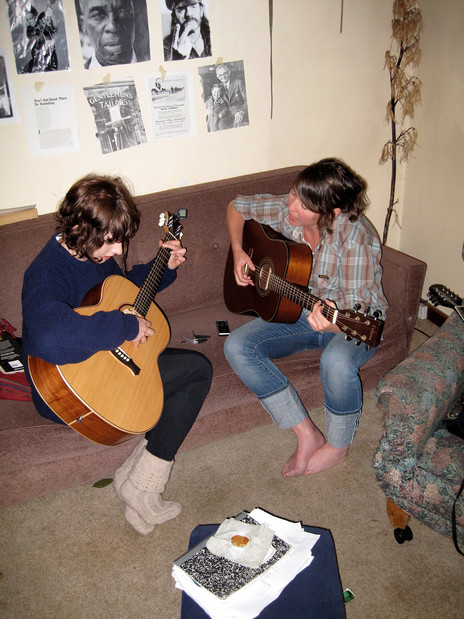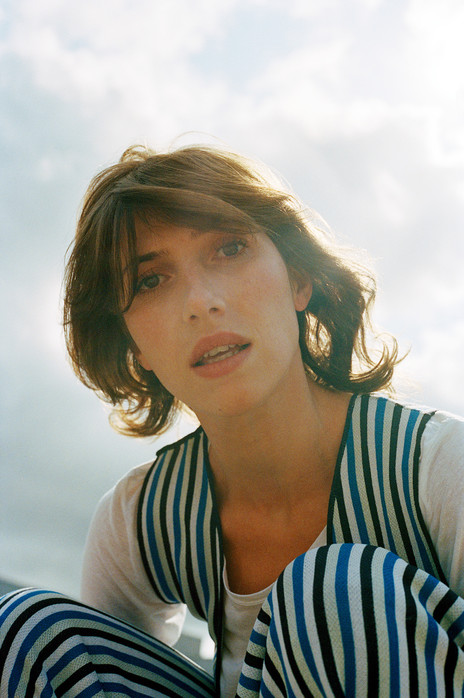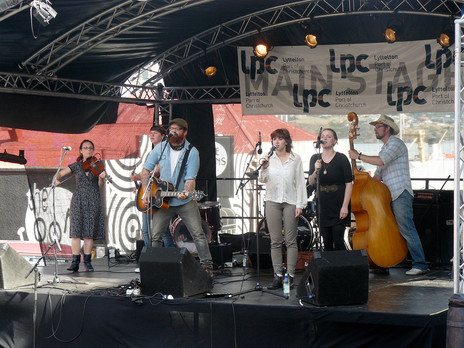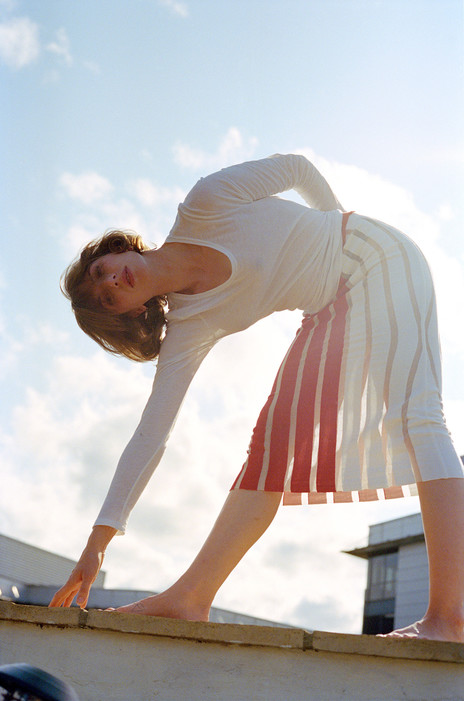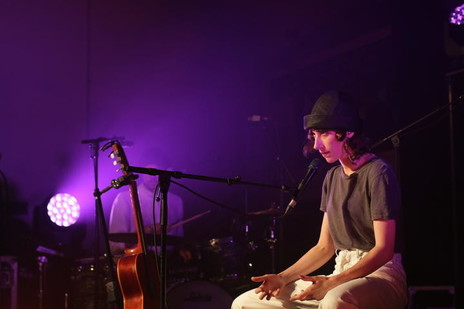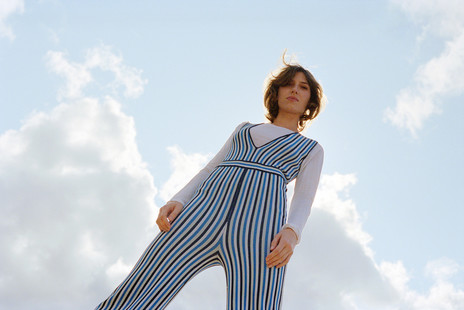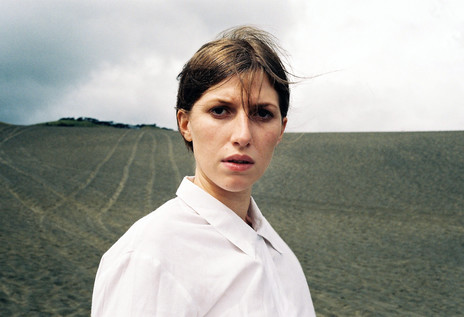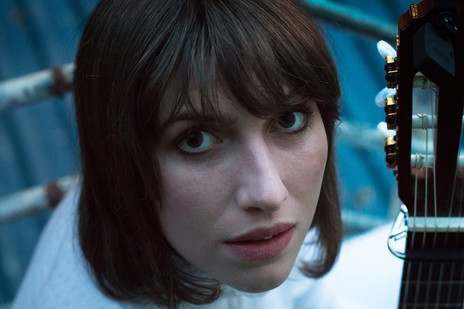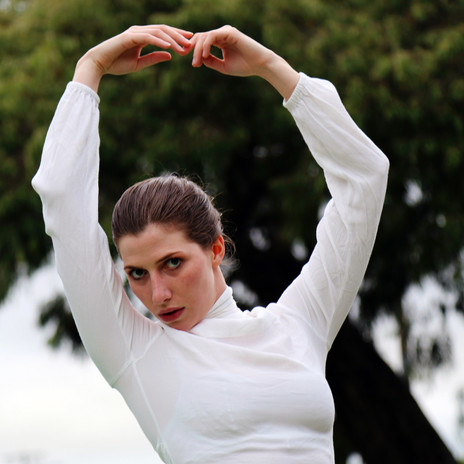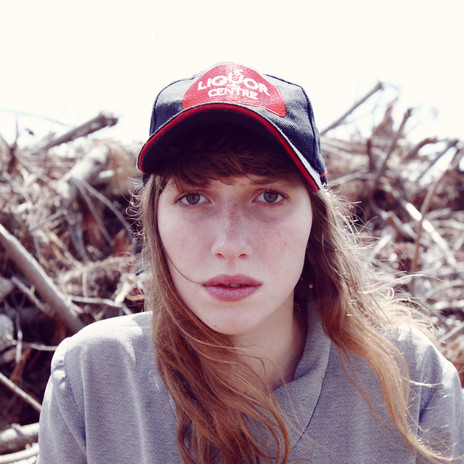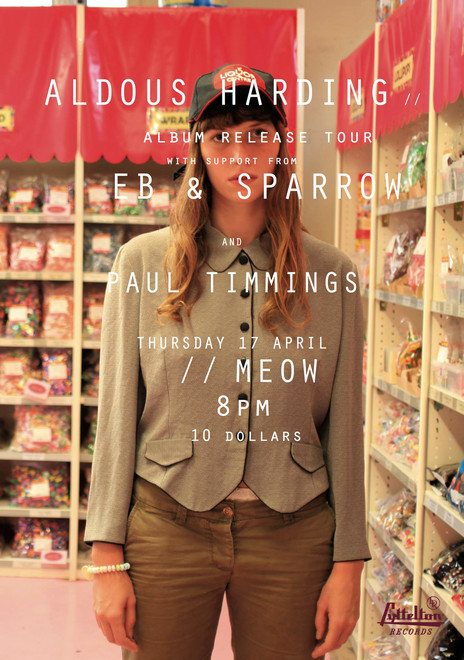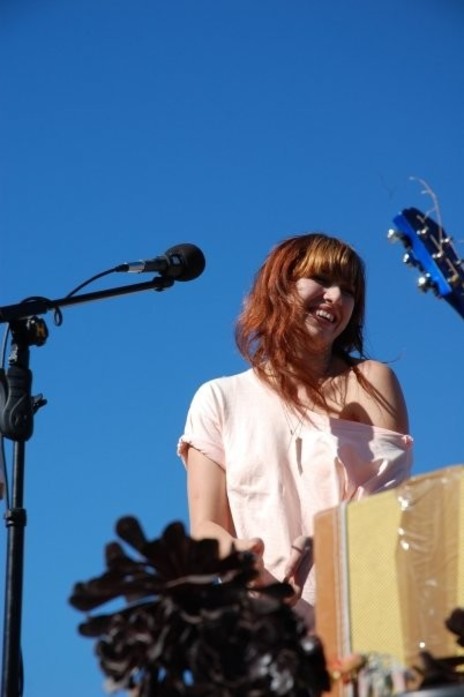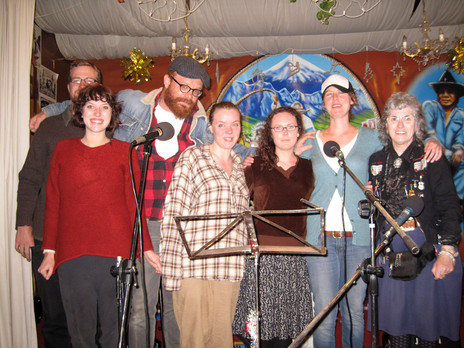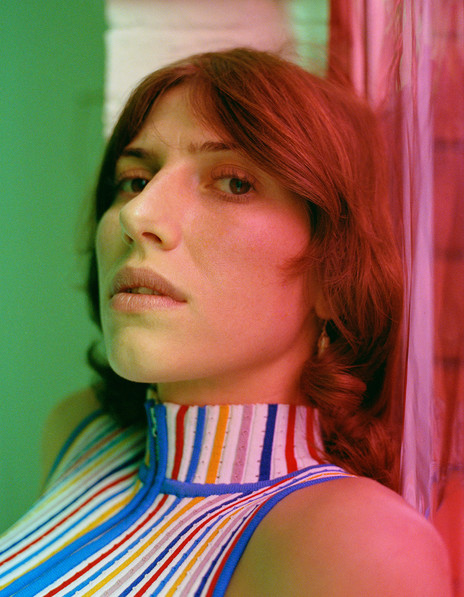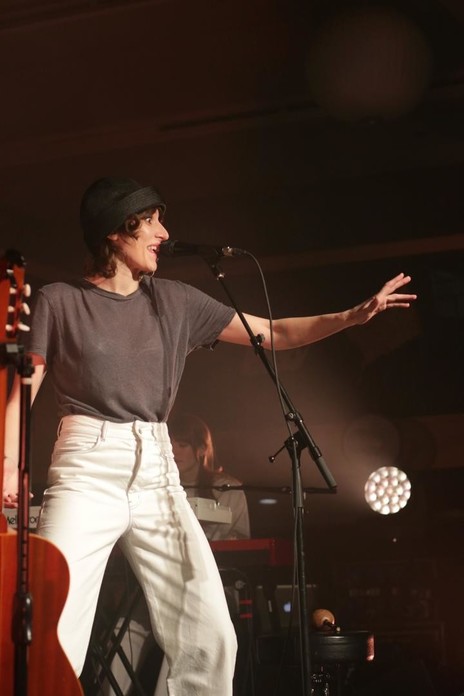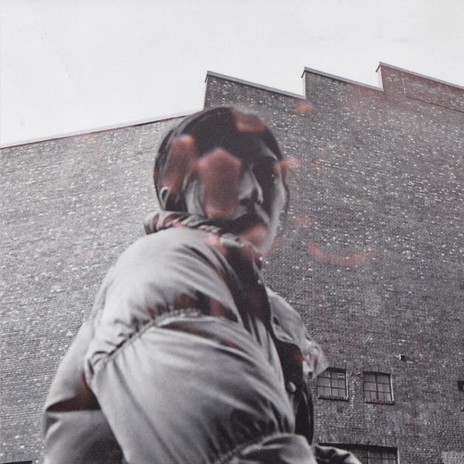Her voice is technically brilliant and emotionally affecting, her songwriting chops are solid and original, but it’s the delivery of it all that makes her stand out. It’s polarising though – many seeing her live for the first time walk away as converted fans, finally understanding the hype. Others are completely confused. Is it all an act? Or is she really as batty as she looks on stage?
“There’s not really anything real about any of this,” she told RNZ in 2017. “It’s a plan, it’s a performance.”
Around the same time, she spoke to NPR’s Bob Boilen. “I can be a number of things, and I’m drip-feeding it,” she told him. “It’s an authentic experiment but I just want to take my time, I don’t want to rush it.”
Her song ‘Living the Classics’, from her breakthrough 2017 album Party, gave some clues as to her ambitions: “Can’t fight the feeling / gonna make it / I won’t stop turning / ’til I’m twisted ...”
Music journalists try to get a glimpse of what Hannah Harding is really like, behind Aldous’s affected accents and kooky dance moves. They try in vain to get solid biographical details, or candid anecdotes. Occasionally she lets her guard slip, and she speaks about addiction issues, or anxiety, but not in any concrete terms. Often it’s a torturous experience, waiting for her slow, meticulously worded answers, which still don’t relieve the enigma. Interviews can be as perplexing as her live performances.
“I don’t really like to talk about what my songs are about,” she told the New York Times. “I know exactly what my songs are about, and I try not to tell people.” She told a friend of hers once about ‘Stop Your Tears’, a song from her first album. “Now she has to distract herself and look elsewhere when I sing the last verse about being at the river with the baby, because she knows too much.”
Three albums in, she told RNZ, “I’m 28, it’s early. It’s early in my relationship with you, and the people listening, we’ve got lots of time to work it out.”
Early Life
Hannah Sian Topp was born in Auckland in 1990. Her mother, actor, singer-songwriter and puppeteer Lorina Harding emigrated to New Zealand from Canada a couple of years earlier. Hannah’s father was also musical and gave her her first guitar.
Her parents divorced early in Hannah’s life, and she and her mother settled in Dunedin. She’s talked about being a fearful and lonely child but had a little radio next to her bed to keep the anxiety away.
As a child, at night, she would dance in her pyjamas, in the dark, to the Top 10.
In an interview with NPR’s Bob Boilen in 2017 she said, “I would get up in the dark, with the moon coming in through the window and I loved to dance, so I would dance in my pyjamas, in the dark, to the Top 10. Just the worst stuff you could imagine, but that’s all I had, you know?” She talks about finding a cassette, aged eight or nine, of the Seals and Crofts hit ‘Summer Breeze’ and having it on repeat, certain that she’d never hear a song she loved more. She cites Toto’s ‘Africa’ as one of the best songs ever written.
“I guess I spent a lot of time wishing I was other places, or wishing I was somebody else, or experiencing something else,” she told The Irish Times. “Maybe my imagination really drank from that, I’ve got no idea. It’s probably a better question for my mum. She might just go, ‘yeah, well she was a drama queen, she’s fine’, and then I’ll probably nod and go, ‘yeah, she’s right’.”
Her mother remarried when Hannah was 11, and the pair moved to an organic flaxseed farm in Geraldine. There was a folk music festival held on the land for many years, the last of which, in 2016, Aldous headlined.
She made her recorded debut aged 13 on her mother’s 2004 album Clean Break, which won the Tui for best folk album. They co-wrote the song ‘Exactly What to Say’, a mother-daughter duet with poignant lines from Lorina: “But the things that happened to me back then, I don’t want them to happen to you.”
Despite music being in the blood, Hannah says she never wanted to be a musician. “I always resisted, when I was younger, because I associated it with being poor, and separated, and not being home, you know?”
Hannah finished her high-school years back in Dunedin, attending Logan Park High School with Nadia Reid and fiddler Flora Knight, both of whom remain very close friends. She loved animals, so she thought she might study to be a vet.
“It wasn’t until my late teens that I started writing and playing music, but I didn’t think I would do it as a career. I just thought ‘oh, well this is something that I can do, and I like to do’.”
In 2008 she was busking in Christchurch. Though she only knew a few guitar chords at the time, Adam McGrath of The Eastern heard her vocal talent a mile off.
“I was busking too around then,” says McGrath. “She was in my usual spot.”
They found a song they had in common, a John Prine number. He asked her to join the band on the spot, and she turned up that night for their gig at the Wunderbar.
ADAM MCGRATH: “[ALdous] MADE EVERYONE LOSE THEIR BREATH WITH HER VOICE, ATTITUDE, AND BRAVERY.”
“She made everyone lose their breath with her voice and attitude and of course her bravery, singing with a band with no rehearsal and no idea of the songs.”
“She had a wild, no-prisoners energy all wrapped up in this great expansive intelligence and humour.” says Adam. “She scared and confused half the people she met, and the other half fell over themselves to be in her presence.”But she disappeared after that first gig. The Eastern went rambling around as they do, and Hannah went overseas, travelling around Europe and living in Quebec for six months, working in a café. It wasn’t until a year later that they reconnected, and she joined the band officially for a couple of years, until she “fizzed out”.
Solo
Through recording with The Eastern, Harding connected with producer Ben Edwards and Delaney Davidson. She had made a start on a solo album, with Marlon Williams sitting in as co-producer, by the time the devastating Canterbury earthquake happened in February 2011.
Harding was busking in Cashel Mall when the quake hit. Facades of buildings collapsed around her, and some people were later pulled from rubble. She escaped unhurt, but presumably rattled, and headed home to Geraldine.
In October that year she made the local paper for another busking story. She had been performing outside the Geraldine bakery, trying to earn enough for a ticket to see Anika Moa that night. Moa walked by, flung some money in the case, and asked Hannah to open the gig. Two hours later she was on stage, playing her own songs. Moa was so impressed she offered her a recording space in Auckland for a week. Though the two got on well, and have mutual respect for each other, those recordings never saw the light of day. By summer 2012 she was back to making her album with Ben Edwards and Marlon Williams in the dingy concrete makeshift studio under the Lyttelton supermarket.
They were emotionally charged sessions. She spoke of her song ‘No Peace’ with RNZ’s Nick Atkinson, saying: “I was very sad, and very fragile, and that particular recording, I’d just had a 20-minute anxiety episode. Ben wanted to send me home, but I was like, actually this is probably the best time to record it.”
Harding’s 2014 debut was a gothic-folk record, full of dark, desolate, bloody images.
What emerged many moons later in 2014 under the name Aldous Harding was a gothic-folk record, full of dark, desolate, bloody images. Murder ballads, the Bible, and mythology all seemed to influence the stories – it was about madness, romance, the fight between good and evil, and primal fear. Her voice, ghostly and geographically ambiguous, impressed local critics such as Nick Bollinger, who said that it “shifts the air with rarefied grace”.
“I have no idea how that sound came out of me on my early songs,” she later told Grant Smithies. “My themes are old, and I felt old, and a bit … cursed. A bit witchy. And I’d only just started properly writing songs, so I was still trying to find my voice. I just arrived at that sound, and it helped me get away with singing those dark words.”
“I might go and get a degree in zoology now,” she off-handedly remarked to Under The Radar in an interview that year.
Party
By 2015 she’d followed her heart and her mate Marlon Williams, for whom she had fallen, to Melbourne. They were living above a pub, both doing the hard yards, taking up support slots around the country, and writing songs.
Friend and tour buddy, Melbourne musician Laura Jean, was fresh from recording an album with producer John Parish, well known for his collaborations with PJ Harvey. Aldous liked the production she heard, and Parish agreed to produce her follow-up. In mid-2016 she went to Bristol to record with him, the sessions yielding the album Party (2017). She told The Guardian about the working relationship: “Every now and again we’d rub up against each other like two old porcupines about stuff, but he’s so gentle and patient.”
Aldous started to play some of the songs live, and her performances floored people. There’s a one-camera clip of her and Jonathan Pearce playing ‘Horizon’ at Whammy Bar filmed in red-hot close proximity by Steve Abel, with sound recording by Andre Upston. Three bare piano chords repeat before Aldous, dressed in white, snarls up to the mic pulling at her lip. With a powerful, chest voice, and clear enunciation she sings, “Let me put the water in the bowl / for your wounds, babe”. It’s intense. “Here is your princess, here is the horizon,” she gestures. This isn’t the same quivering character from the last album. Aldous has arrived, clearly in focus now. And though some characters are still frail and vulnerable, others are bolshy and know exactly what they want.
On tour, Harding stunned critics and A&R people, and had her pick of record deals.
She toured throughout 2016, stunning critics and A&R people, and had her pick of record deals. In March 2017, Party was released on the prestigious British label 4AD. Her impressive voice was flanked by chalky clarinet and saxophone, gently plucked guitars and minimalist piano. Some of the album’s songs were still dark and unsettling, but there were moments of bright joy and hope as well.
The New York Times asked about the dramatic range of voices on the record. She replied, “Just like using an instrument, a song calls for different things. They’re all my voices, and they all come from different places of the same thing.”
The music videos that came with the album exploited her beguiling screen charisma and the dance training from her younger years, particularly the video for ‘Blend’, which saw her dancing – in a nod to Apocalypse Now – in a star-spangled cowgirl bikini, a pink pout, white boots and gun holsters. She performed on BBC’s Later… with Jools Holland on the same night as Lorde performed ‘Green Light’. Under the bright TV lights, her facial quirks and theatrics were magnified. Some hated it, some loved it, and Aldous couldn’t care less what they thought.
Party won her an international fan base instantly and she toured relentlessly for the next 18 months. She won the Taite Prize of 2018 and only narrowly lost out to Lorde on the APRA Silver Scroll for ‘Horizon’.
Though ‘Weight of The Planets’ wasn’t included on Party, it was written around the same time, and closed out her sets on that tour. Maybe the lyrics articulate the way she saw herself then: “I can do anything / no one is stopping me / I can be anything / but I’ve got the weight of the planets / I’m lost ...”
Designer
While Marlon Williams released a wallowing, green-tinged, highly personal post-Aldous-breakup record in 2018, Aldous went the opposite direction. In 2019 she released Designer, an album filled with shuffling beats, surrealist lyrics, and a levity and playfulness we hadn’t heard before.
Poaching a couple of musicians from Cate Le Bon’s band, including H Hawkline (Huw Evans) on bass, synths and backup vocals, and Stephen Black on saxophone, she returned to John Parish for the recording.
Her friends talk about her sense of humour, and it came through in songs such as the title track, ‘Designer’: “That visionary shimmer / do not lose your young eyes / laughing at good work with your ugly son / give up your beauty, designer”.
The first single off the album, ‘The Barrel’, came complete with a classic Aldous/Martin Sagadin music video. She shuffles around, looking down the barrel of the camera while dressed in a pilgrim-like costume inspired by surrealist film-maker Alejandro Jodorowsky. Three minutes in, she’s a blue-masked goblin, and by the end, she’s in her underwear, wielding shakers. ‘The Barrel’ was awarded the 2019 APRA Silver Scroll Award.
‘Designer’ (2019) showed that Harding wasn’t going to be pigeon-holed into the sad-girl music box.
The album showed that Aldous wasn’t going to be pigeon-holed into the sad-girl music box, that she was capable of reinvention. Despite the evidence to the contrary, Aldous told RNZ that she felt unremarkable.
“Because I never thought I would ever make anything. I always felt too messy and too malleable, and too distractible, to ever stick at anything to make it interesting. When an unremarkable person manages to make something that other people say is remarkable on some level, that’s quite a feeling.”
In June 2021 Aldous released the recording and video for a song she closed her sets with back in 2019, the jaunty ‘Old Peel’. In the video, co-director Martin Sagadin is on the other side of the camera, a wiry, Iggy-esque figure gyrating behind the mic. We get glimpses of Aldous, but she’s hiding, maybe underground somewhere.
--
Aldous Harding's fourth album Warm Chris was released in March 2022, having been fully recorded at Rockfield Studios in Wales. Harding settled in Cardiff with her Welsh partner, fellow musician H. Hawkline (Huw Evans) in 2020, although she told Pitchfork some of the new songs were written at her mother’s home in Geraldine. Warm Chris marks her third collaboration with producer John Parish, but the album feels quite different from Party and Designer, just as Party and Designer are distinct from each other.
The new album was met with a stamp of approval from major international outlets. A common thread in the reviews is an appreciation for the album’s seemingly unconnected, but linguistically pleasing lyricism.
“… on ‘Lawn’, you have to suppress a giggle when Harding rhymes ‘They don’t mean a thing to me’ with ‘All these lamps are free!’ wrote Pitchfork in a 8.2 review. “She favours this kind of free association, unconnected turns of phrase that synthesise the strange, lonely resonance of staring at a piece of abstract art or visiting an empty beach in winter … The feelings you have when you experience these songs are yours alone.”
In an interview with Pitchfork, Harding confirmed this approach is consciously part of her ethos. “I just want everyone to feel like a philosopher. You put on a record, and that record belongs to you for that 40 minutes. That’s all I wanna protect.”
Warm Chris received a four star review from The Guardian (“endearingly introspective folk-pop”), an 8.5 from Der Spiegel (“songs that enchant you and won't let you go, even if you can only guess what they mean”), and was critic’s pick for the New York Times: “… like David Byrne in his big suit or David Bowie playing harlequin, Harding’s is a grounded eccentricity … As with all of Harding’s best work, Warm Chris is an offbeat, infectious and ultimately liberating invitation to stop making sense.”
In both her Pitchfork and RNZ interviews for the new album, Harding discusses how she doesn’t feel like a musician, but rather, an actor. It is a fascinating perspective to bring to the listenership of Warm Chris, with Aldous’ ever-changing vocalisation and fluid lyrical themes.
– Update by Rosie Howells, March 2022
